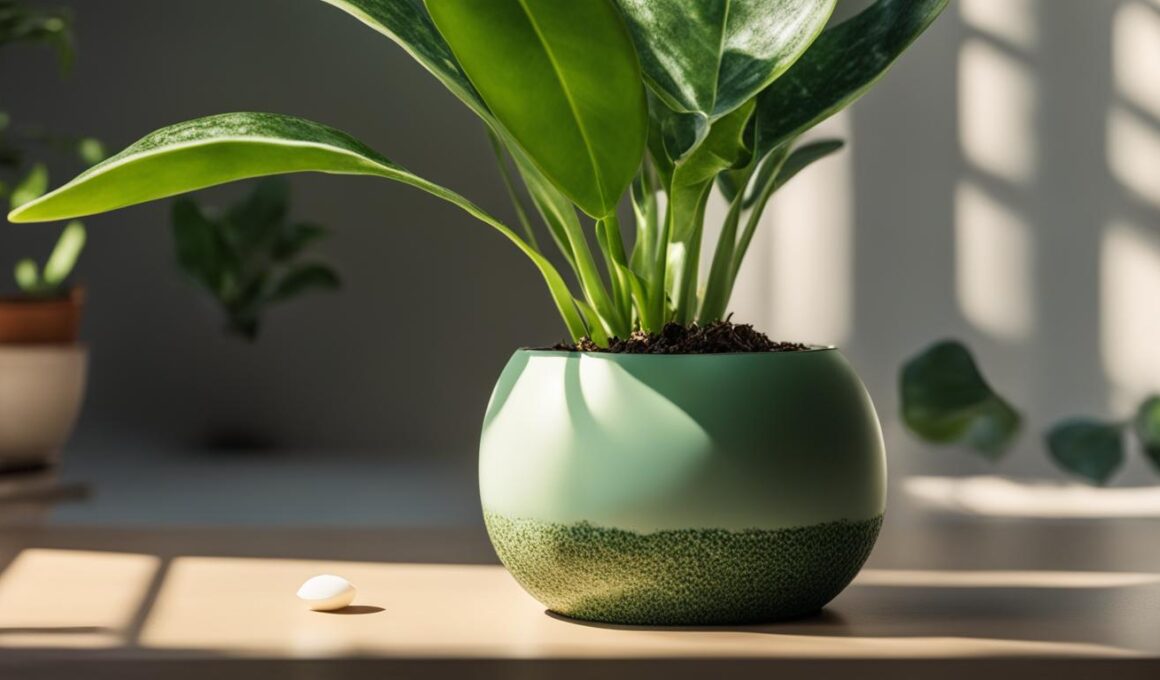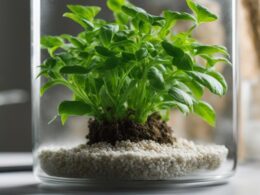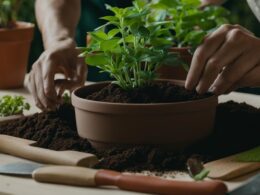Eggshells are considered a natural and beneficial fertilizer for houseplants. They contain calcium, which is essential for plant growth and development. Crushed eggshells can be used to provide a slow-release source of calcium to plants, preventing calcium deficiency-related issues. Using eggshells as a fertilizer substitute is a cost-effective and eco-friendly option for promoting lush growth in your indoor garden.
Post Summary:- Eggshells are a natural and beneficial fertilizer for houseplants.
- They contain calcium, which is essential for plant growth.
- Crushed eggshells provide a slow-release source of calcium, preventing deficiency-related issues.
- Using eggshells as a fertilizer substitute is cost-effective and eco-friendly.
- It promotes lush growth in your indoor garden.
How to Use Eggshells as a Fertilizer for Houseplants
Eggshells can be a valuable and natural source of calcium for your houseplants. To use eggshells as a fertilizer, you’ll need to follow a few simple steps:
- Dry and clean the eggshells: After using eggs in your kitchen, rinse the eggshells with hot water to remove any remaining residue. Then, allow them to dry for one to two days. This step is important to prevent any potential mold or pest issues.
- Crush the eggshells: Once the eggshells are dry, you can crush them into a fine powder. You can use a mortar and pestle, a blender, or simply crush them using your hands. It’s important to ensure that the eggshells are finely crushed to make it easier for the plants to absorb the calcium.
- Apply the eggshell powder: Sprinkle a small amount of the crushed eggshells into the soil of your houseplants. It’s best to start with a small quantity and gradually increase it if needed. Water your plants as usual, and the eggshell powder will gradually release calcium into the soil, providing a nutrient boost to your plants.
It’s important to note that not all houseplants may benefit from eggshell fertilization. Plants that require calcium, such as roses, African violets, Monstera, and philodendrons, tend to benefit the most from this natural fertilizer hack. Additionally, it’s crucial to monitor your plants for any signs of nutrient imbalances. If you notice any issues, such as yellowing leaves or poor growth, consider adjusting the quantity of eggshell powder you’re using or consulting with a plant care specialist.

Using eggshells as a fertilizer for houseplants is not only a sustainable and eco-friendly option but also a cost-effective one. Incorporating this natural calcium supplement into your plant care routine can help promote healthy plant growth and prevent nutrient deficiencies. Give it a try and see the benefits for yourself!
Did You Know?
The calcium content in eggshells can also help neutralize acidic soil. If you have plants that prefer a slightly acidic or neutral pH, such as tomatoes or peppers, using eggshells as a soil supplement can be particularly beneficial.
Experiment with different methods of using eggshells as a fertilizer and observe how your plants respond. It’s a simple yet effective way to provide essential nutrients to your houseplants while reducing kitchen waste.
Other Ways to Use Eggshells for Plant Care
In addition to using crushed eggshells as a fertilizer, there are other creative and eco-friendly ways to incorporate these natural wonders into your plant care routine. Let’s explore some unique uses for eggshells that can benefit your plants and garden.
Organic Calcium Water
One of the simplest ways to make use of eggshells is by creating organic calcium water. To do this, boil a handful of crushed eggshells in water for about 5 minutes. Allow the mixture to cool overnight, and then strain the liquid to remove any shell particles. This calcium-rich water can be used to hydrate your plants, providing them with a natural nutrient boost. Simply use it in place of regular water during your watering routine to promote healthy growth.
Seed Starters and Propagation Pots
Eggshells can also serve as convenient seed starters and propagation pots. Carefully remove the top portion of an eggshell, making a small opening. Fill the shell with nutrient-rich soil and plant your seeds or cuttings inside. The eggshell provides a protective environment for germination and root development. Once the seedlings or cuttings are ready to be transplanted, you can place the entire eggshell pot directly into the ground. The shell will naturally decompose and enrich the soil, while also providing extra calcium for the growing plants.
Pest Control and Natural Drainage
If you’re dealing with pesky garden pests like slugs, eggshells can act as a natural deterrent. Crushed eggshells create a rough texture that slugs find uncomfortable to crawl over, helping to protect your precious plants. You can create a barrier around your garden beds or individual plants by sprinkling crushed eggshells on the soil surface. Additionally, eggshells can be placed at the bottom of plant pots as a natural drainage hole cover. This prevents soil from escaping while allowing excess water to drain effectively.
As you can see, eggshells have multiple uses beyond just being a fertilizer. They can provide calcium-rich water for watering, serve as seed starters, act as a pest deterrent, and even aid in drainage. Incorporating eggshells into your plant care routine is not only beneficial for your plants’ health but also an eco-friendly and sustainable choice. So, the next time you crack an egg, don’t throw away the shells. Give them a second life in your garden and watch your plants thrive!
How to Prepare Eggshells for Plant Use
Before using eggshells for plant care, it is important to properly prepare them. Start by rinsing the eggshells with hot water to remove any residue. Then, allow them to dry for one to two days before use. Alternatively, you can sanitize the shells by boiling them or baking them in a low-temperature oven. Once the eggshells are clean and dry, you can crush them into a fine powder or use them as broken pieces, depending on the intended method of application. Store any leftover crushed eggshells or eggshell powder in a sealed container in a dry location.
Table 1: Steps to Prepare Eggshells for Plant Use
| Step | Description |
|---|---|
| Rinse | Rinse the eggshells with hot water to remove residue. |
| Dry | Allow the eggshells to dry for one to two days. |
| Sanitize | Optional: Sanitize the eggshells by boiling or baking them. |
| Crush | Crush the eggshells into a fine powder or use them as broken pieces. |
| Store | Store any leftover eggshells in a sealed container in a dry location. |
Properly cleaning and preparing eggshells for plant use ensures that you are providing your houseplants with a safe and beneficial source of calcium. The rinsing process helps remove any potential impurities, while allowing the shells to dry thoroughly prevents the growth of bacteria or mold. Sanitizing the eggshells can provide an extra level of protection against pathogens. Once the eggshells are prepared, they can be crushed into a powder or used as broken pieces, depending on how you plan to use them in your plant care routine.
Storing the eggshells in a sealed container in a dry location helps maintain their quality over time. It is important to protect them from moisture, as excessive moisture can cause the shells to break down or become moldy. By taking these simple steps to prepare and store your eggshells, you can ensure that they are ready to provide a nutrient boost to your houseplants when needed.
Can Using Eggshells in Ceramic Pots Benefit Houseplants?
Using eggshells in ceramic pots and planters for healthy plants can certainly benefit houseplants. Crushed eggshells can be added to the potting mix to provide a slow-release source of calcium, magnesium, and other minerals. This helps promote strong and vibrant plant growth while preventing nutrient deficiencies. Additionally, eggshells act as a natural pest deterrent and can help regulate soil pH levels.
Conclusion
Incorporating eggshells into your plant care routine can provide a nutrient boost for your houseplants while also being eco-friendly. The calcium content in eggshells promotes healthy plant growth and helps prevent nutrient deficiencies in your indoor garden.
By using eggshells as a fertilizer substitute, you can contribute to reducing kitchen waste and adopting a more sustainable approach to plant care. This cost-effective and natural solution not only benefits your plants but also the environment.
Experiment with different methods of application, such as crushing eggshells into a fine powder or using them as broken pieces, to determine the best approach for your plants. Observe the results in your houseplants and adjust the quantity of eggshells accordingly to avoid nutrient imbalances.
Can Eggshells Benefit Easy-to-Care-for Houseplants?
Eggshells can benefit easy care houseplants for you. They are a great source of calcium which can help prevent blossom end rot in tomatoes and peppers. Crushed eggshells can also be used as a natural fertilizer for your easy care houseplants, providing them with essential nutrients for healthy growth.
FAQ
Are eggshells good for houseplants?
Yes, eggshells are considered a natural and beneficial fertilizer for houseplants. They contain calcium, which is essential for plant growth and development.
How can I use eggshells as a fertilizer for houseplants?
To use eggshells as a fertilizer, you need to dry them out and grind them into a fine powder. This powder can be sprinkled sparingly into the soil when watering your plants to increase the calcium levels.
What plants benefit from using eggshells as a fertilizer?
Plants that require calcium, such as roses, African violets, Monstera, and philodendrons, benefit most from using eggshells as a fertilizer.
Can eggshells be used for other purposes in plant care?
Yes, eggshells can be used as seed starters, drainage hole covers, pest deterrents for slugs, and can provide extra nutrients for birds and worms.
How should I prepare eggshells for plant use?
Start by rinsing the eggshells with hot water to remove any residue. Then, allow them to dry for one to two days before use. Alternatively, you can sanitize the shells by boiling them or baking them in a low-temperature oven.









